A turbocharger may look like some large, prehistoric species of snail, but its effect on an engine guarantees a lift in performance that no one would associate with the sloth-like dawdle of the humble mollusc. In the simplest terms, turbos recover energy from the exhaust-gas stream that would normally be lost to the atmosphere. When it comes to car mags, turbos are usually to be found on high-performance models, their telltale whistles signalling pumped-up power and pruned acceleration test times. However, turbos are now de rigueur for the transport industry; there’s hardly a new truck on our roads these days that doesn’t have one. For the truckie, the whistle of a turbo attached to his engine signals increased efficiency. For us at this magazine, the sound is like the early-warning siren of an air raid: it’s time to take cover, to be on your guard, for skids and tyre-shredding action are never far away.
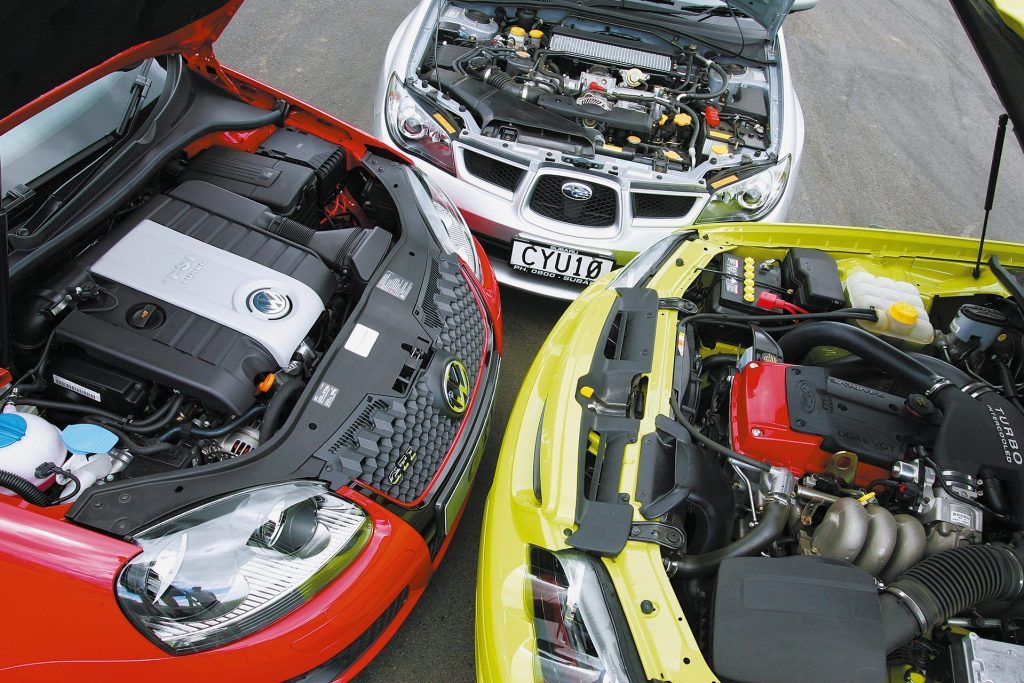
If you’ve followed the fortunes over the last decade of a recognised turbo manufacturer like Garrett, you’ll have noticed this has been a period of unparalleled growth for boost specialists. The development of new turbo technologies such as variable-vane geometry has eliminated the ‘lag’ in power delivery that plagued the earliest turbocharged cars. Meanwhile, better cooling systems and reductions in bearing friction have increased the service life of turbos to match the other mechanical components of a vehicle. Couple these advances to the increased intelligence of the latest engine-management systems, and you have the turbocharged cars of today. They’re almost frustratingly reliable compared with the slow-fuse ‘grenades’ of yesteryear, and the throttle response and smooth power delivery are now generally superior to those of normally-aspirated engines.
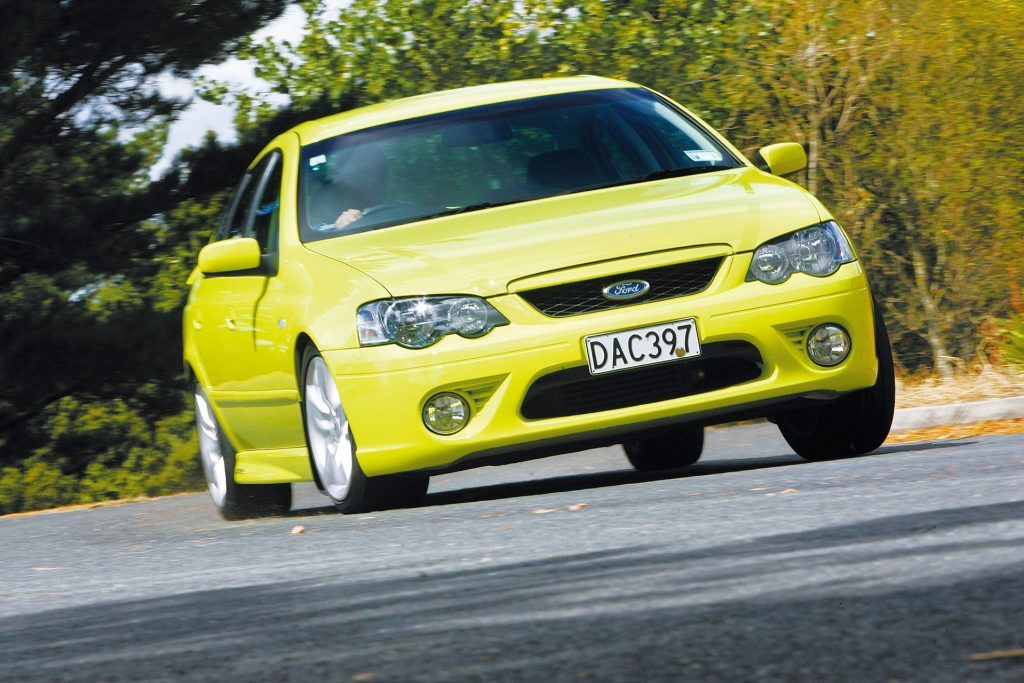
These advances haven’t gone unnoticed by car makers seeking to add a performance model to an existing car range. Installing a turbo and an intercooler is a comparatively easy and affordable process that will increase a car’s pace dramatically. Instead of shoehorning a larger-capacity ‘atmo’ engine into the cramped space under the bonnet, engineers can quickly find a home for a ‘snail’. As for cost, companies such as Garrett and MHI have the hardware already refined and have amortised that development over the production of millions of units. Ease of application and economic factors have seen turbos embraced with increasing enthusiasm by most mainstream brands. These days, it’s far easier to count the high-volume car makers that don’t have a turbocharged model in their mix (notably Honda and bugger-all others) than those that do.
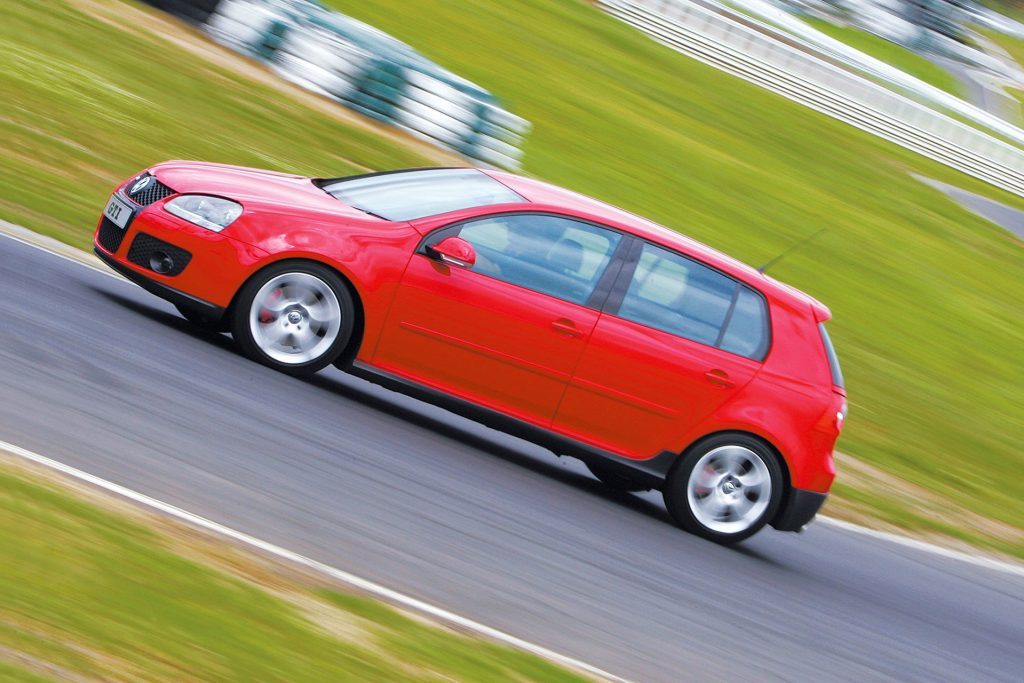
It is this turbo renaissance that sees us gathered at Pukekohe raceway with three of the best boosted-up sportsters on the market. We’ve focused on a $45,000-$55,000 price niche, and gone shopping for the best bang-for-buck that the $10K-wide bracket could buy. In truth, the cars virtually picked themselves. All three wear nameplates that have at some stage earned the title of Performance Car of the Year at this magazine. So step forward Volkswagen Golf GTI (PCOTY 2006), Falcon XR6 Turbo (PCOTY 2004), and the holder of the 1996 title, the effervescent Subaru Impreza WRX.
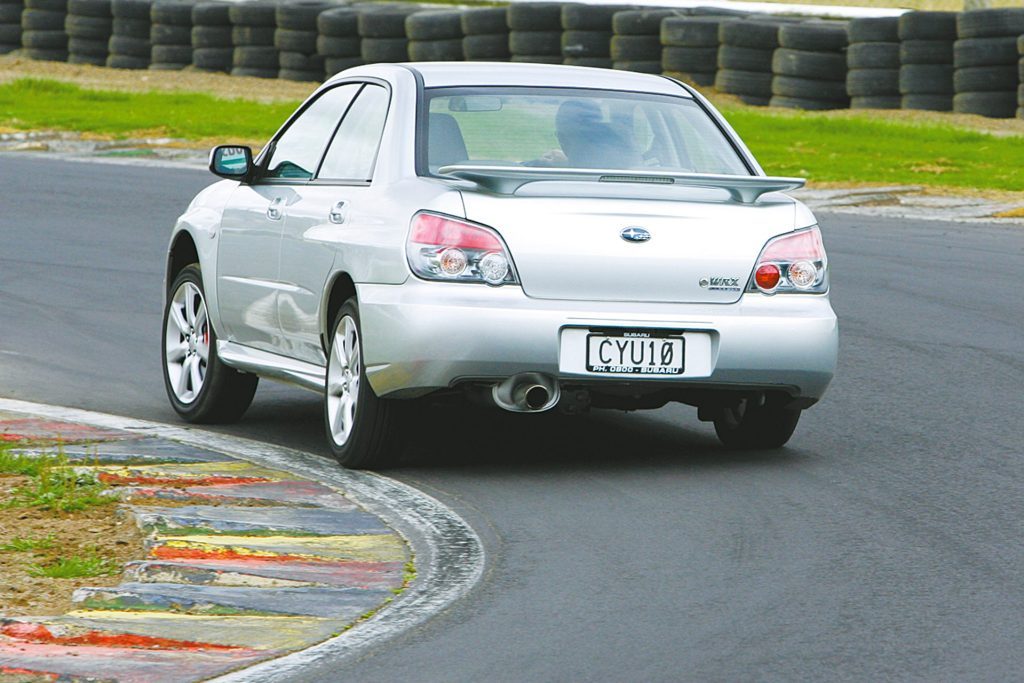
Naturally, the Golf GTI remains unchanged from the car that’s so impressed us since its New Zealand launch in 2005, but both the XR6 Turbo and WRX have progressed substantially from the models that won their PCOTY titles.
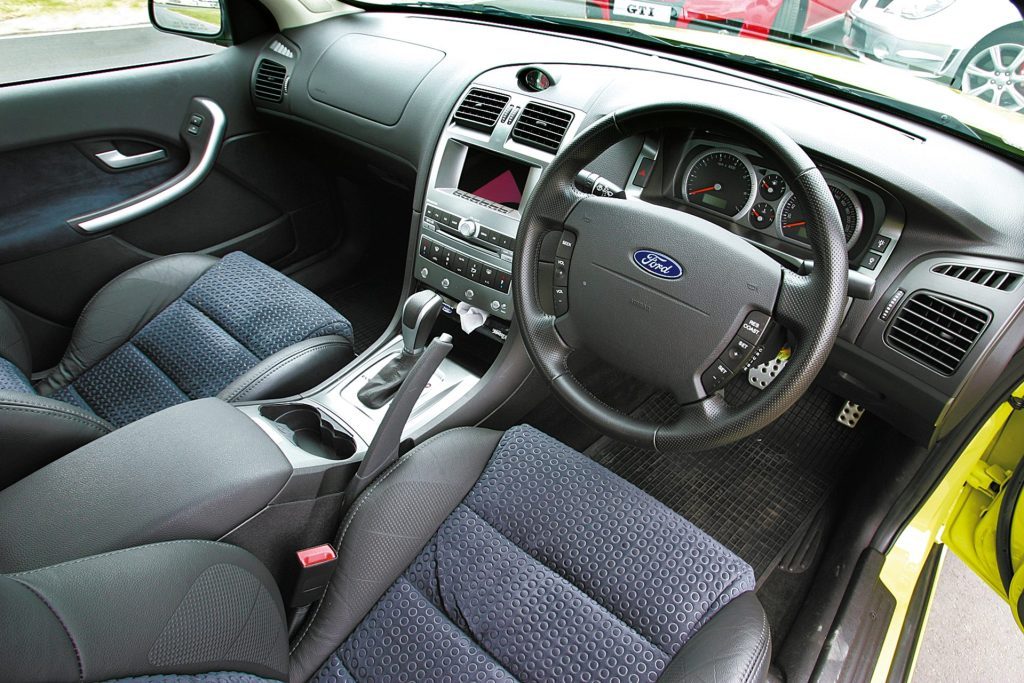
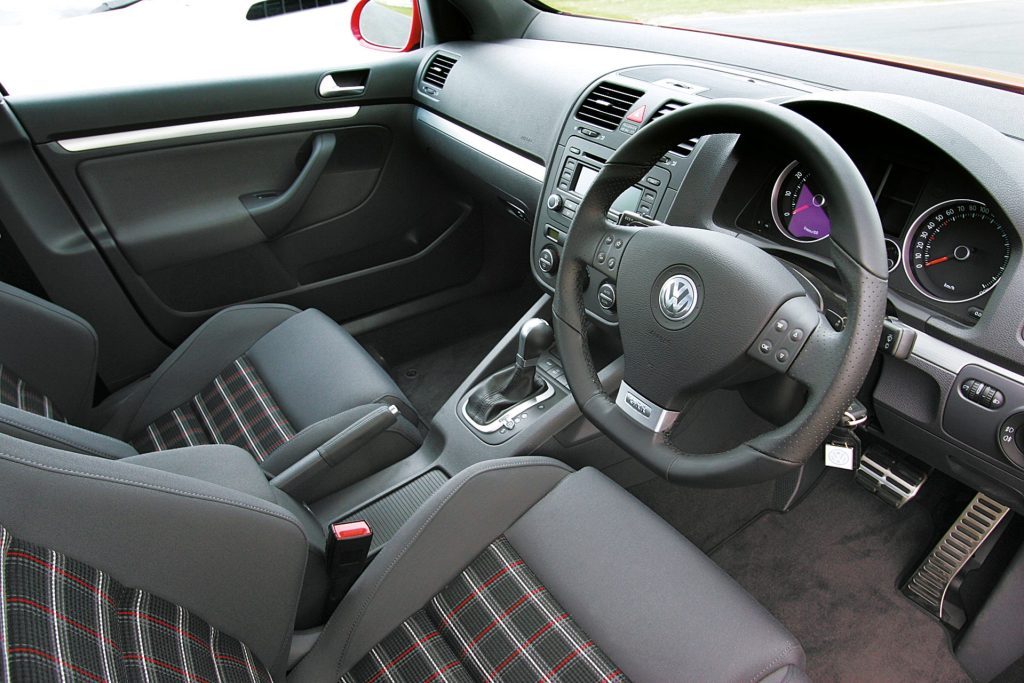
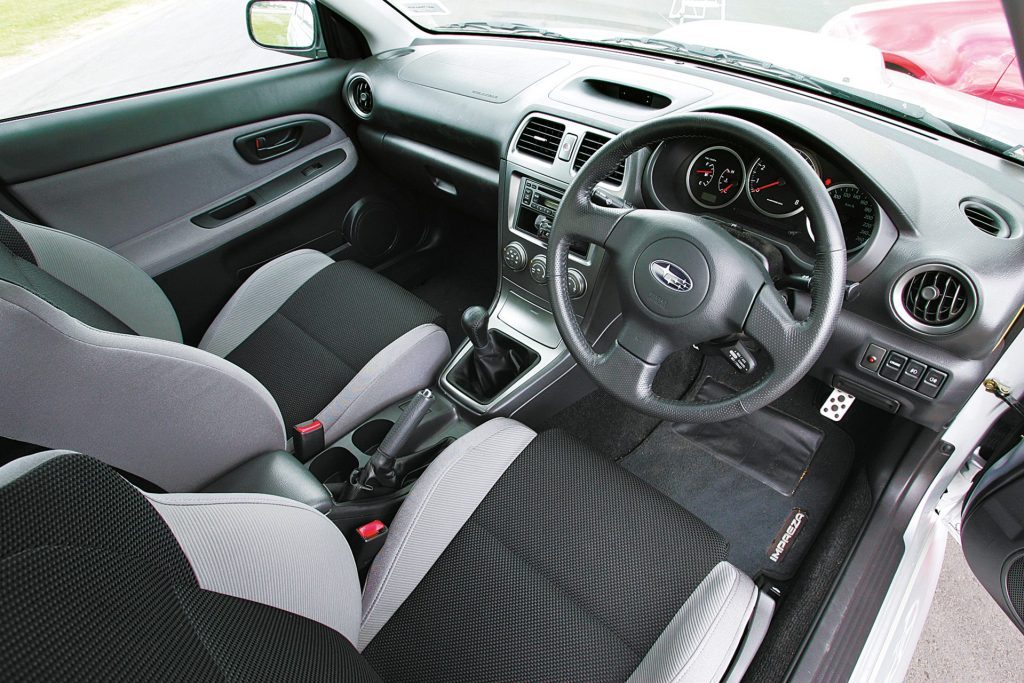
As a new BF Falcon version, the XR6T uses ZF’s fantastic six-speed automatic to good effect, especially now that Ford has boosted the torque output of the 245kW 4.0 litre inline six to 480Nm to get the tranny’s hydraulic juices really flowing. With the extra powertrain muscle comes increased refinement. The wild colonial car of this bunch now drives in more hushed tones thanks to better noise suppression in the cabin. The loudest thing about our ‘Citric Acid’-coloured sample car is the paint job.
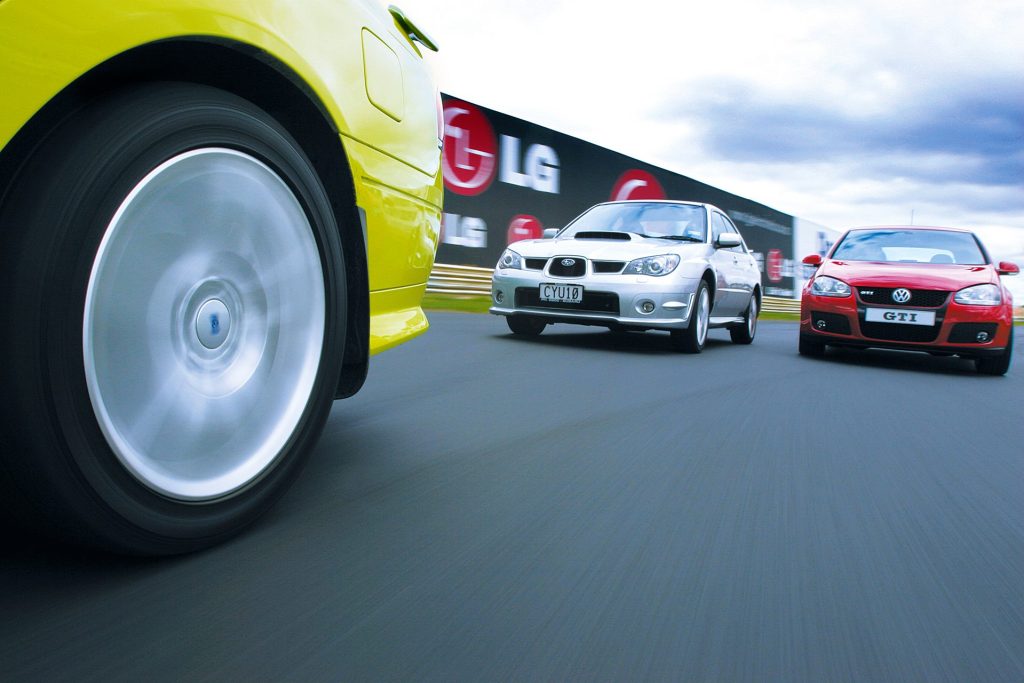
Ten years of WRX development has made our silver 2006 model unrecognisable from the 1996 title-winner. It has matured and grown in just about every respect and dimension. Yet few of these changes have taken place under the bonnet – until this year. The big news in the latest upgrade is an extra 500cc of cubic capacity, which takes the displacement of the boosted-up boxer four to 2.5 litres. The 4.0mm increase in the piston strokes and a 7.5mm increase in the diameter of the cylinder bores may have created another 463cc of engine capacity, but has had little effect on the peak power produced by the Rex. The power gain is just one kilowatt, but of more note is the way that power arrives earlier in the rev range. Where the peak of the previous 2.0 litre engine flowed through the gearbox at 6000rpm, the 169kW maximum of the 2.5 arrives at 5600rpm. The latest model also generates a healthy 36 per cent increase in torque output at basement engine speeds – something that would prove quite handy when trying to keep pace with both the over-achieving Aussie car and Europe’s finest sports-hatch during this comparison test.
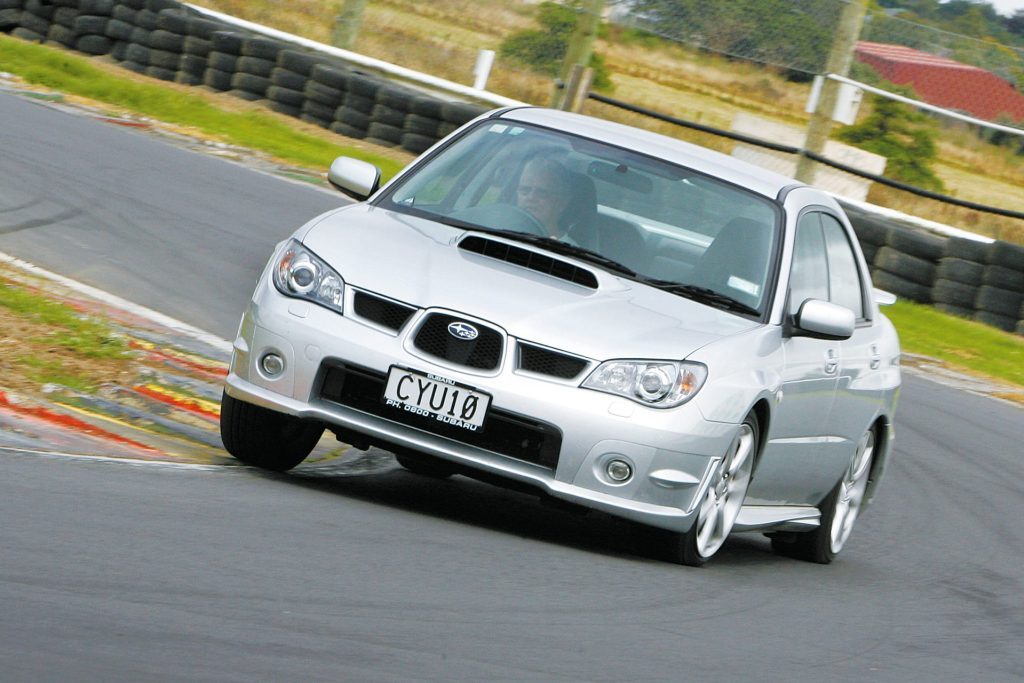
On paper, the Golf GTI looks the runt of this litter, the 2.0 litre direct-injection turbo developing ‘only’ 147kW of peak power. Yet that’s not the way it feels from the driver’s seat, thanks to the potency of the power delivery throughout the rev range. Direct fuel injection plus a turbo that is the most eager of these three cars to get into action bless the Volkswagen with bottom-end grunt unrivalled by other hot-hatches. The torque peak arrives with just 1800rpm on the dial and hangs tough through the rest of the rev range. Couple this omnipotent torque spread to a car that is some 340kg lighter than the XR6T, and you have a real weapon for New Zealand back roads. Although the slowest of this pack in terms of outright performance, the GTI is still a hard car to keep in sight in real-world driving conditions.
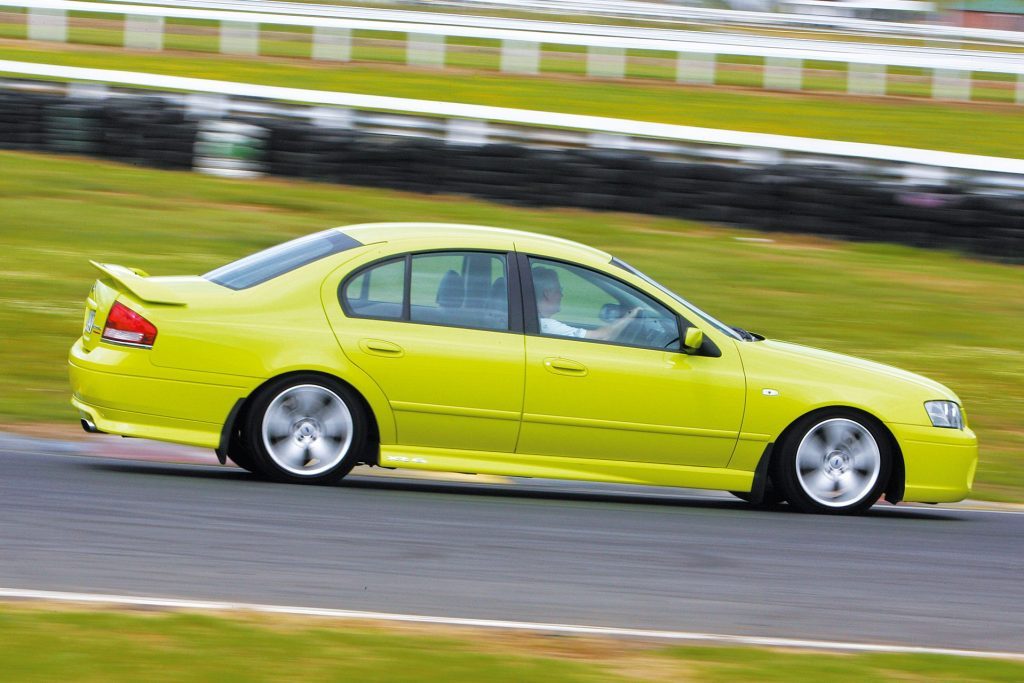
The ‘gang of three’ all take different routes to put their prodigious power to the road. The Subaru adheres to a core brand value for the company, the all-wheel-drive track; similarly motivated, the Falcon stakes out the rear-drive turf; the Volkswagen puts it all up front. Each in this test avails its driver with a different kind of torque processor: the Impreza provides the same notchy-yet-drivable five-speed manual that characterised the original WRX while the Falcon uses the aforementioned six-speed auto; and with its six-speed Direct Shift Gearbox, the GTi offers the convenience of an auto with the efficiency of a manual. The DSG is the trickest of the bunch, but the twin-clutch transmission does come with a mass penalty; it weighs almost twice as much as a conventional manual gearbox, and contributes several of the 59 extra kilograms that the Volkswagen carries above the 1390kg WRX. It came as some surprise when the four-wheel-drive car proved to be lighter than the front-driver during the weigh-in.
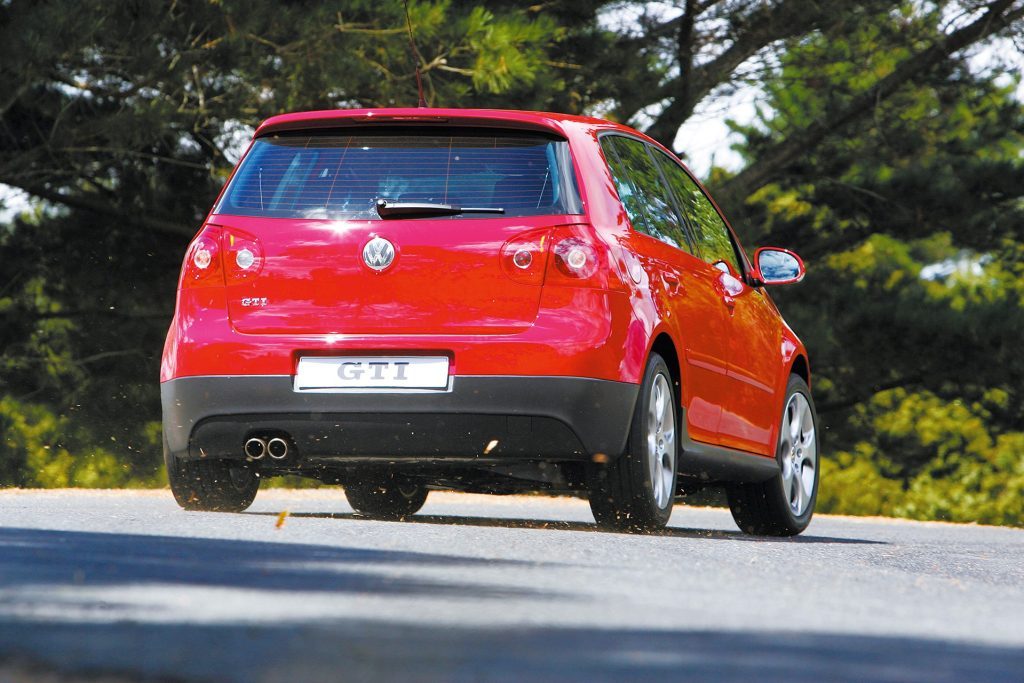
OK, seconds out, it’s time for the real boxing match to begin. Off the line, it’s the WRX that achieves the quickest getaway, its 4wd making it the favourite of bank robbers the world over. But the Falcon is soon huffing and puffing its way past, and its powerful top-end reels in the Impreza at around the 100km/h mark. It’s too late for the Ford to win the 0-100km/h honours, but the XR6T goes on to record the fastest 80-120km/h time by a considerable margin, and is the only car of the three to go under the four-second barrier. As for the Golf, it might be a little slower than the other two in feats of acceleration, but it has a powertrain that endears itself in other ways. It is easily the most frugal of the trio in terms of fuel use, and it is the only one with an exhaust wastegate that dumps boost during the upshifts with such neat sound effects. We could happily listen to the latter during a year or ten of GTI ownership.
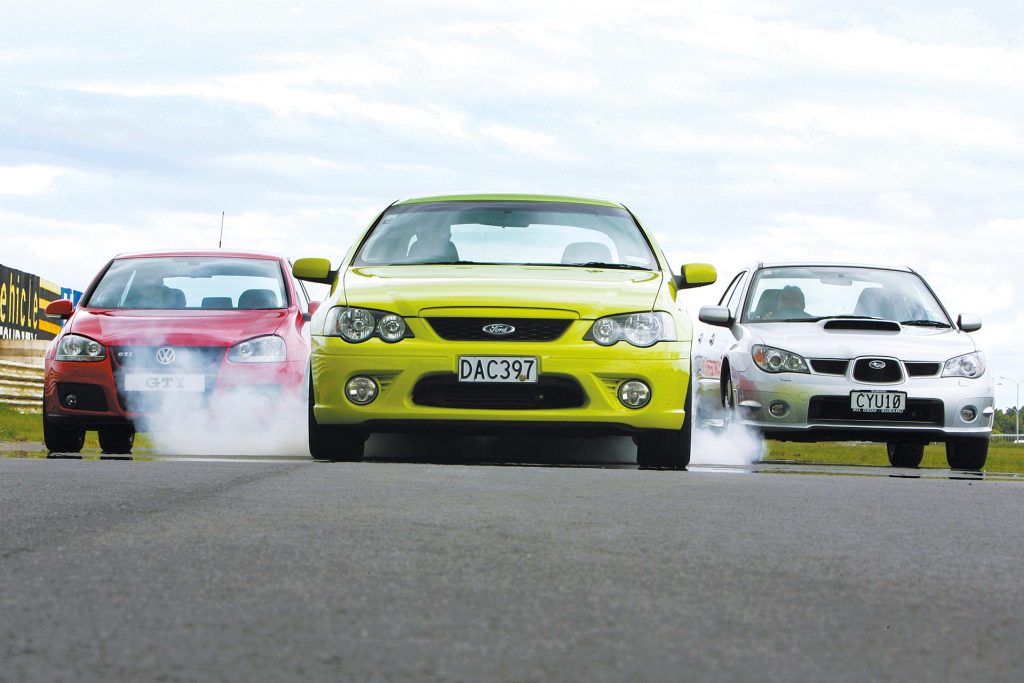
We hit the picks hard at the end of our on-paper drag race, and, to our eye-bulging surprise, find the heaviest car stops soonest. The Falcon is the king of the 100-0km/h braking test, while the Impreza brings up the rear, with a stop that is a metre-and-a-half longer than the XR6T, and a metre further than the Golf’s. Yet the Subaru offers the best pedal feel on road. By comparison, the Falcon’s felt like stepping on a three-layer sponge cake, and the Golf’s needed another jandal-sole’s worth of travel before it would do the business.
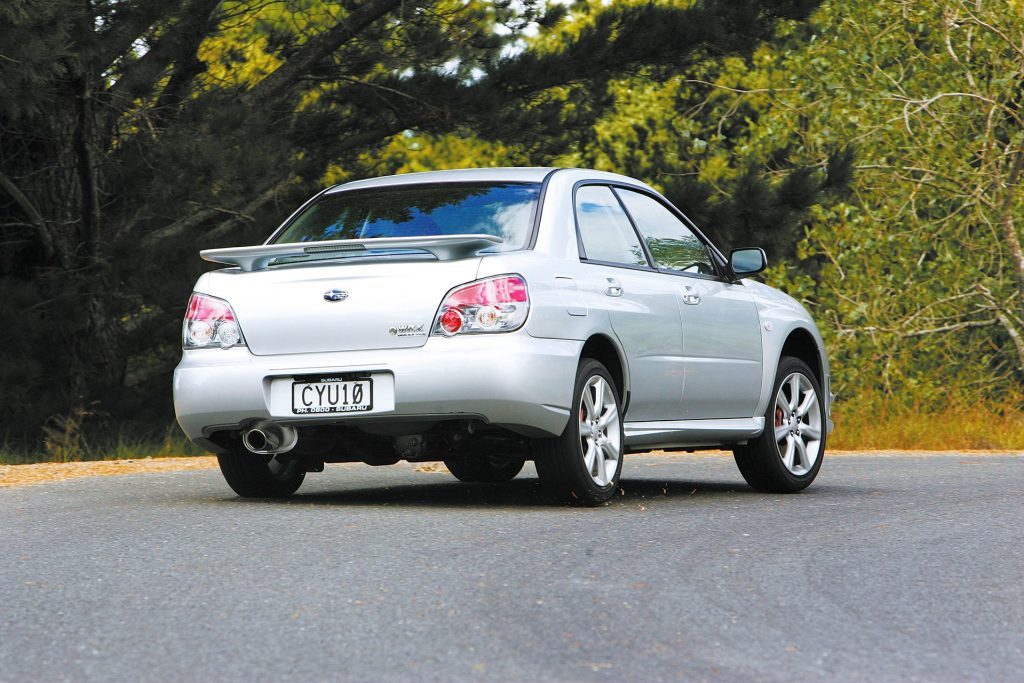
Track testing revealed little about the three cars other than the Impreza’s natural ability to hook up and drive off the apex earlier than the other two. If the upgrading of Pukekohe had permitted, it would have been interesting to run a few laps to see whether the Falcon’s extra speed on the straights would have negated the Subaru’s ability to get the torque to the road more efficiently. That wasn’t an option with the front straight full of contractors’ vehicles, so it was time to head into the real world.
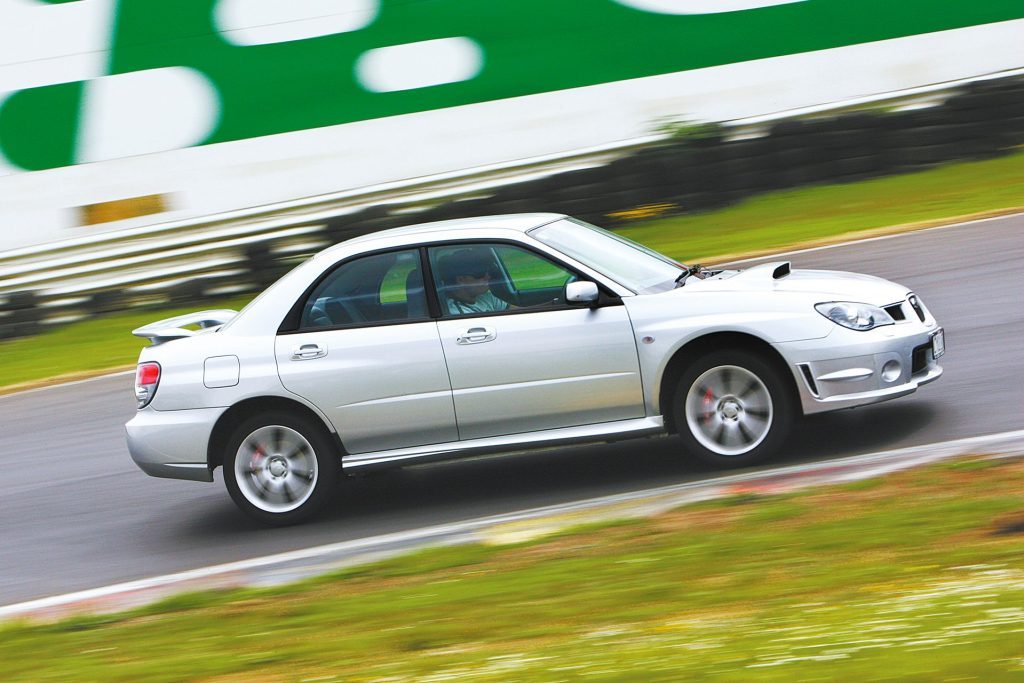
Here, the Golf GTI excelled. It has the best ride/handling compromise of the three – which is saying something when the other two cars are the WRX and XR6T. The Japanese and the Aussie are also capable of providing a supple ride over a wide range of speeds, but there’s always a hint of firmness that the German effectively masks. Carry a blind mother-in-law in the back of either of the others and you’ll risk becoming a target for criticism about your hedonistic choice of family car.
The Ford and VW simply can’t drive off the curves as hard as the Subaru: the XR6 Turbo will be lighting up the rears with speed-snuffing oversteer, and the GTI will be wasting its prodigious torque by uselessly spinning both front tyres.
Cabin quality is another win for the Golf, with one proviso: if not splashing out on the factory leather option, the seats come upholstered in garish chequered fabrics. Otherwise, it’s the clear choice if you judge a car by its lounge room. Where the Falcon’s over-soft seats and the Impreza’s dated dash design let them down, the Golf is all class and the ‘designer car’ of the three.
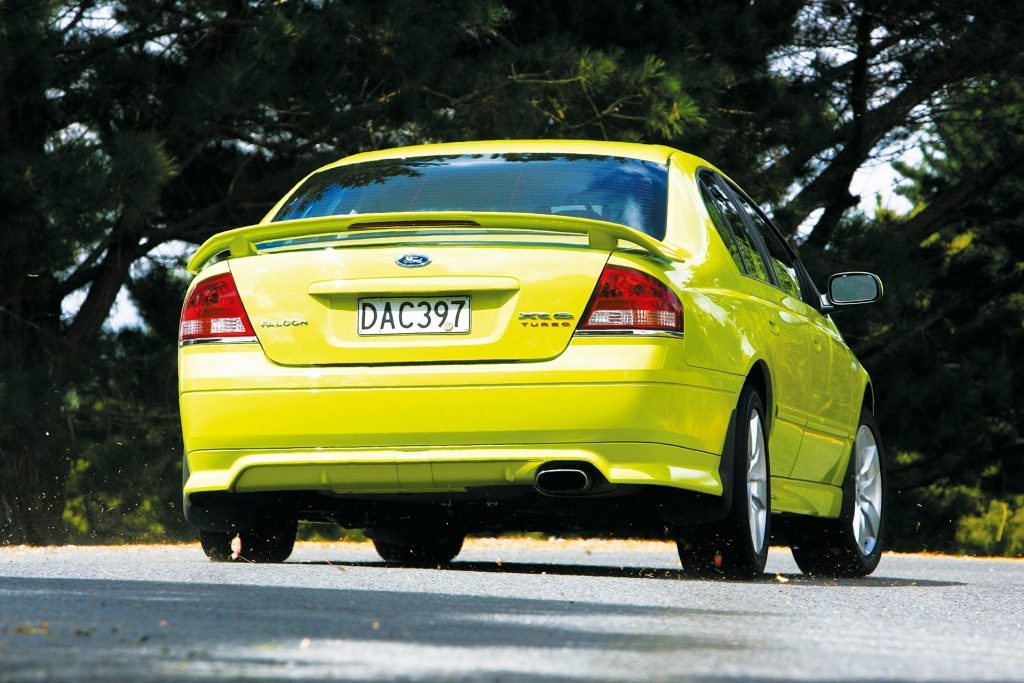
But we’re here to discuss which is the best ‘driver’s car’, OK? And that title must go the Subaru’s way. For starters, it is the only one that relies completely on its ‘mechanical’ grip to maintain cornering stability. At the wheel of the WRX you are master of your destiny whereas in the others you are at the mercy of their electronics, which will intervene if they feel the car is in danger of being tossed into ‘the salad’. The Impreza is also the car that fits best in terms of driving position. The Falcon sits you too high for a sports-oriented vehicle, and you feel sited further away from the centre of gravity. The seats of the XR6 Turbo also lack the lateral support they need in a car so capable of generating lateral-g, and they seem more tailored to the needs of heavyweight pro wrestlers than slimmer drivers.
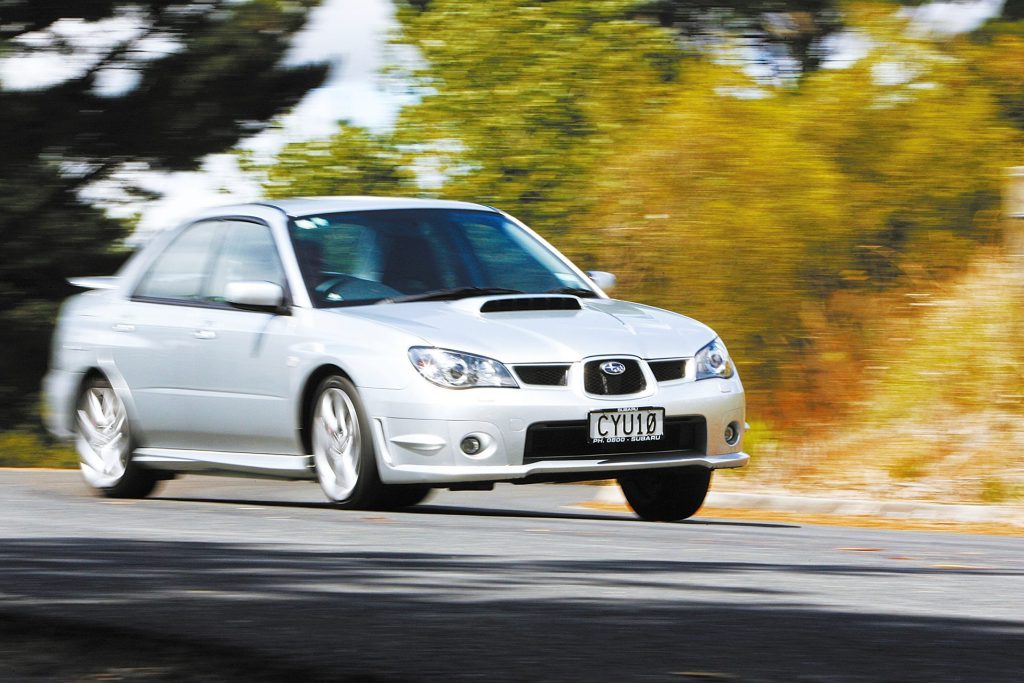
While the Golf does get the driver positioning and support right for a sports-hatch, it isn’t quite as involving to drive as the Impreza. Some of this has to do with the DSG, which, although an absolute technical marvel, can’t quite offer the same driving rewards as a well-considered manual. Then there’s steering feel, the one blemish in the Golf’s dynamics. Although an exciting corner-carver with breathtaking turn-in and a superb, throttle-adjustable chassis balance, the masking of road feedback at the wheel will most suit necrophiliacs.
Most of the committed drivers at this mag believe in rear-wheel drive as the ultimate power-delivery system, and the XR6 Turbo doesn’t disappoint. The chassis is set up to understeer earlier than the other two, but a quick throttle application before the corner apex will have it drifting like a good ’un. Yet the Big Ocker sports-sedan can match neither the sheer agility of the Impreza nor the symbiotic bond it allows between car and driver.
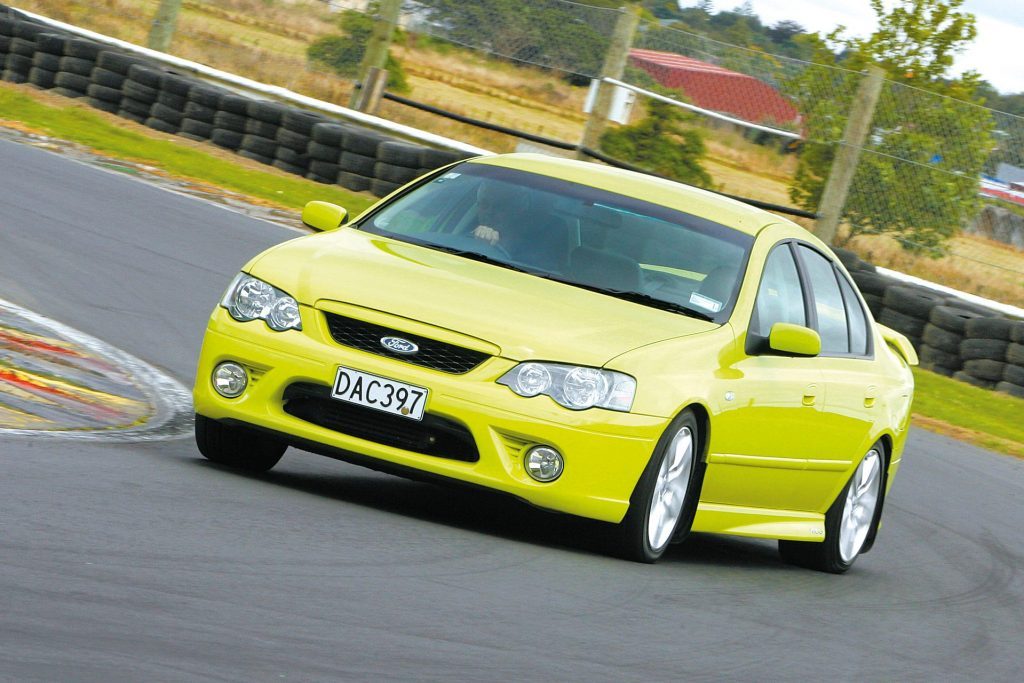
For it’s business as usual at the wheel of the WRX. Ever since Subaru raised the roll centre in 2001 with the launch of the ‘bug-eyed’ version, and extended the wheelbase and track dimensions to match those of the rally racers, the Rex has provided a cornering performance that borders on the classical. You can toss it in hard and instantly break the tail into oversteer, then stomp on the go-pedal to lock the car onto the desired trajectory, and the Subaru will simply hook up and drive off the curve. By comparison, both the XR6T and GTi will trigger their stability systems with dazzling displays of blinking warning lights and cacophonous beeps. Dismiss those well-calibrated systems, and the Ford and Volkswagen simply can’t drive off the curves as hard as the Subaru: the XR6 Turbo will be lighting up the rears with speed-snuffing oversteer, and the GTI will be wasting its prodigious torque by uselessly spinning both front tyres. By the time the smoke has cleared, the Subaru will be long gone.
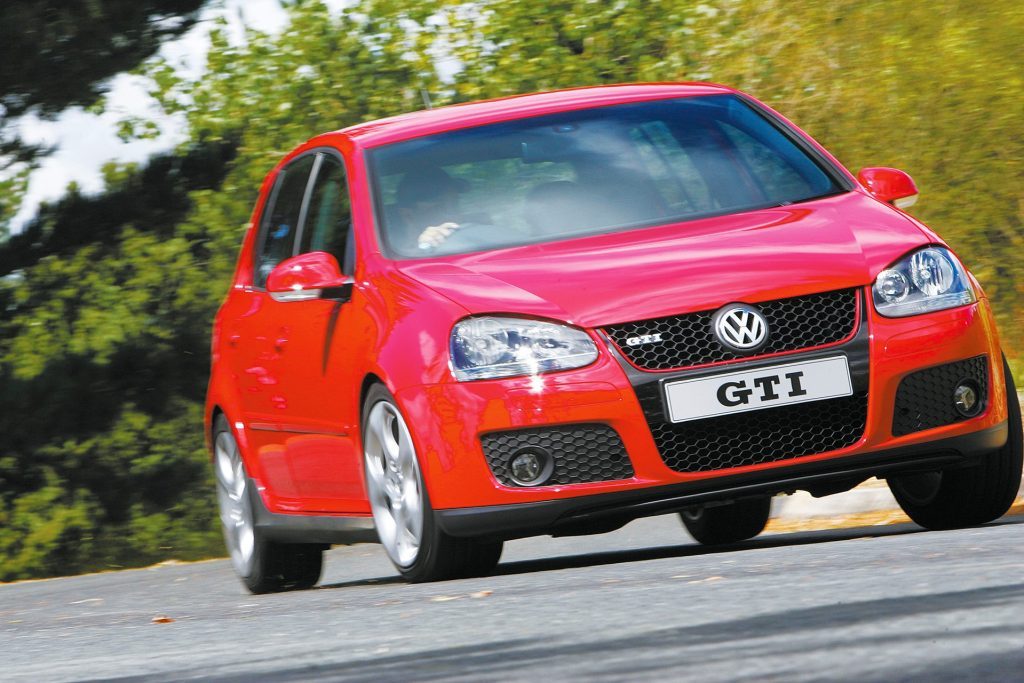
That the Rex manages to achieve such a definitive dynamic performance from its 4wd system without corrupting its steering only underscores the expertise of the engineers that developed it. The Impreza remains best judged by what lies under its dated-looking skin and by what hides behind its uninspiring hard-plastic interior. It also has a thirst that rivals the Falcon’s. If you must compromise your driving enjoyment for the needs of others, the GTI or the XR6 Turbo make better choices. In terms of the trophies we’ve already awarded them, each of these performance cars is a recognised winner. The one that will best suit you will be determined by which of their individual talents or foibles most defines your willingness to compromise.
| Model | Subaru Impreza WRX |
| Price | $44,990 (2005) |
| Engine | 2457cc, B4, T |
| Power/Torque | 169kW/320Nm |
| Drivetrain | 5-speed manual, AWD |
| Fuel Use | 12.0L/100km |
| 0-100km/h | 6.13sec |
| 80-120km/h | 4.12sec (110m) |
| 100-0km/h | 35.95m |
| Stability systems | ABS, EBD |
| Luggage Capacity | 311L |
| Weight | 1390kg |
| Model | Ford Falcon XR6 Turbo |
| Price | $57,990 (2006) |
| Engine | 3984cc, IL6, T |
| Power/Torque | 245kW/500Nm |
| Drivetrain | 6-speed auto, RWD |
| Fuel Use | 13.5L/100km |
| 0-100km/h | 6.16sec |
| 80-120km/h | 3.66sec (97m) |
| 100-0km/h | 34.47m |
| Stability systems | ABS, ESP, EBD, TC |
| Luggage Capacity | 504L |
| Weight | 1785kg |
| Model | VW Golf GTI |
| Price | $52,990 (2005) |
| Engine | 1984cc, IL4, T, DI |
| Power/Torque | 147kW/280Nm |
| Drivetrain | 6-speed twin clutch, FWD |
| Fuel Use | 8.0L/100km |
| 0-100km/h | 7.09sec |
| 80-120km/h | 4.85sec (137m) |
| 100-0km/h | 34.85m |
| Stability systems | ABS, ESP, TC, BA, EBD |
| Luggage Capacity | 55L |
| Weight | 1449kg |
This article was originally published in the 2006 issue of NZ Autocar Magazine.
Got a past review you’d like to see posted online?
Our digital archives go back to the year 2000 and we have tested the majority of the new cars released to the New Zealand market during that time.
Let us know which of our historic reviews you’d like to see by submitting the form below.


